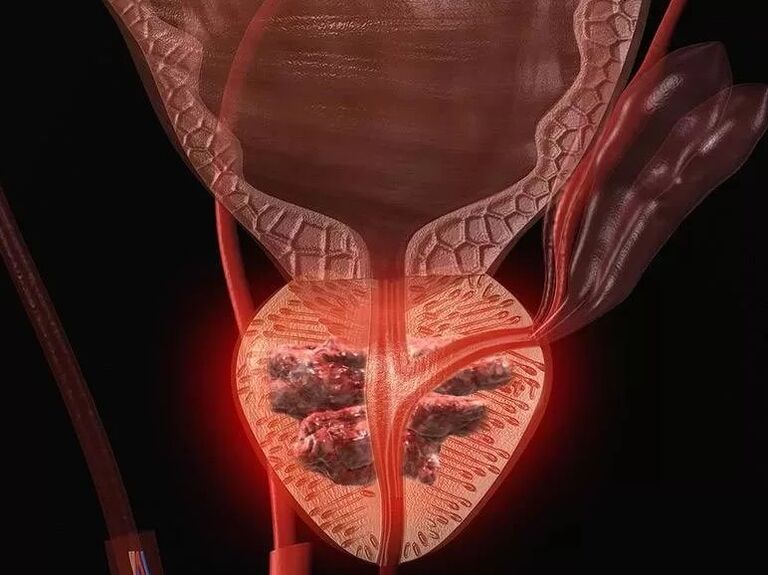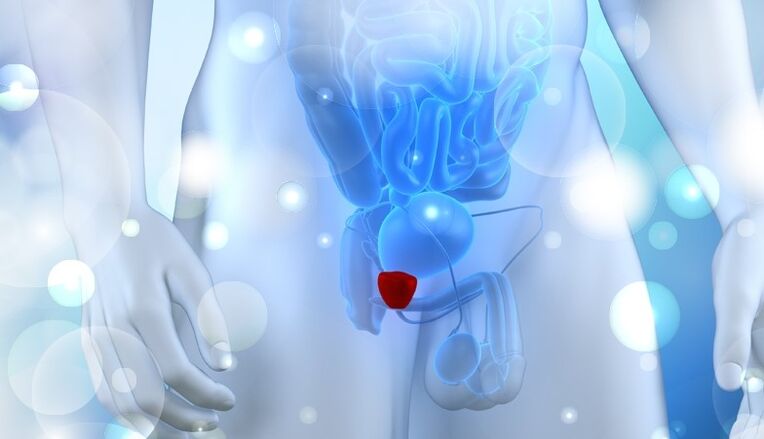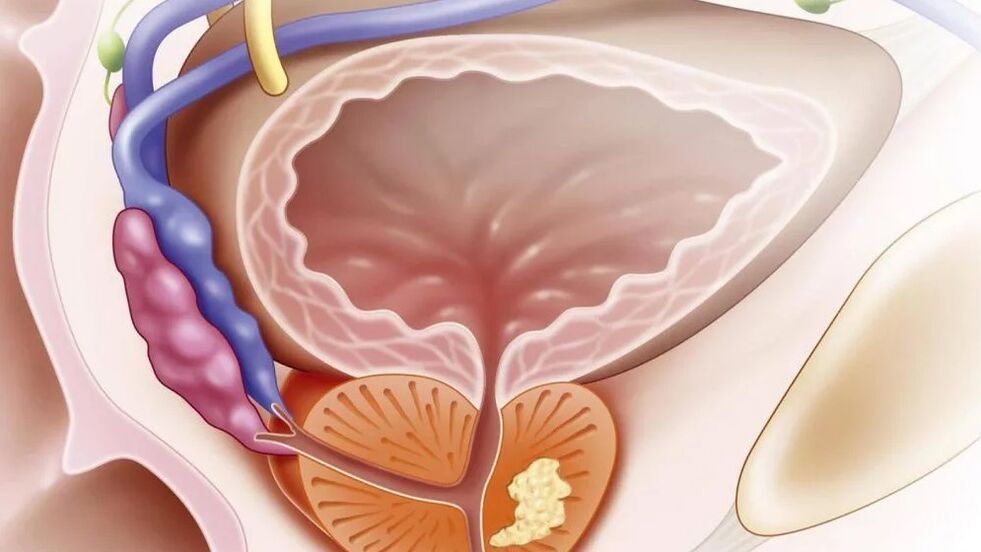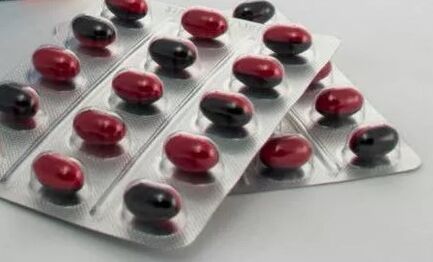One of the most dangerous complications of acute prostatitis can be a abscess of the prostate gland. This is a focal cleansing inflammation that the body temperature can rise to 40 degrees. Signs of abscess are sharp intensive pain and difficult urine. In the absence of medical care, the glands are developed in swelling of tissues and the urethra lumen is completely blocked.

Prostatitis is the most common urological pathology in reporting aged men. According to the survey, at least one thirteen in the life of them experienced symptoms that can be interpreted as an inflammation of the prostate gland. The main reason for the development of bacterial prostatitis is an infection, but only in acute prostatitis, the infection, the prostate gland is acute inflammation, which is explained by the anatomical features of the structure of the male body.
In the chronic form of the prostatitis, the inflammation trigger mechanism, but the inflammation of the prostate gland, which requires treatment, can only develop in the background of other factors:
- The extended hypothermia of a different nature: both in the ice pit, but also in cold stones, but also s.
- Seating (sedentary) lifestyle leading to blood stagnation that can cause inflammation;
- Irregular sex life: This applies to both extreme refusal and extreme activities;
- Urology (eg urethritis, for example) or sexually transmitted (gonorrhea, chlamidia, etc. ): A secret presence of these diseases, the result becomes a prostatitis;
- Regular problems with stool (most chronic constipation);
- The use of spicy, smoked and acidic foods, alcohol and some other products can cause inflammation of the prostate gland
- Other factors that cause immunity: excess loads, lots or long stress.
If the urologist is applied in a timely manner, the acute bacterial prostatitis can only make the urine difficult, but can cause a abscess and edema of a prostate gland.
Last, as an inflammation, between other things, can cause serious intoxication of the body, with a sharp increase in temperature to 40-41 ° C (1 degree acute temperature fluctuations).
However, most of these complications can be prevented, because the manifestations of the prostatitis of this species are generally forcing the patient to postpone a visit to a specialist.
When there is a chronic form of the disease, the symptoms are not clear, but the development of complications without treatment is possible. Inflammation without the relevant drug and therapeutic effects can be spread to other bodies of the genuineinary system that can lead to development:
- cystitis - sack inflammation;
- Pyelonephritis - the kidney inflammation;
- Vesikulitis - inflammation of seed bubbles;
- Inflammation of tests and testicles.

The inflammation of the eggs and testes is one of the most common complications and in turn, for a long time, difficult and always successful, the chances of such complications are being treated faster.
In some cases, the results of a chronic prostatitis can be a transition to its computing form. The calculating prostatitis is characterized by Calculi (small pebbles) in the global excavations (small pebbles) to get rid of it.
In addition, the cause of the prostatitis is a hormonal failure caused by insufficient production of hormones, which has sex glands.
The development of the prostatitis is facilitated in a number of certain reasons. Very often, the signs of prostatitis are often hypothermia and injured in men who lead the life of irregular sex.
In addition, as a result of the decline in the prostatitis, the blood flow and lymph, a hormonal shortcoming in men in the men's small pelvices, a hormonal deficiency, a hormonal deficiency, can be developed as a result of deterioration of blood flow and lymph.
A factor that contributes to the manifestation of the prostatitis is also considered a number of sexually transmitted infections. Therefore, the prostatitis often manifests men after a defenseless combination.
There are 4 basic forms of prostatitis: acute bacterial prostatitis, chronic bacterial prostatitis, non-extracterial prostatitis and prostatio.
In people under the age of 35, the disease usually comes in a sharp bacterial prostatitis. Bacterial prostatitis, the presence of an infection is called when laboratory approval.
Most, Chlamydia, Trichomoniasis, Gardnerelliaz or Gardnerellosis or Gonorrhea. The infection enters the prostate gland through the blood and lymphatic vessels of the pelvis.

However, recent studies prove that in most cases, the infection is based on existing violations in the structure of prostate and blood circulation. Although bacteria from non-bacteria cannot beolated, but this does not rule out their presence.
Chronic forms of the disease are more diagnosed in elderly patients. The prostatode has a clinical picture of the prostatitis, there is a seal of prostate tissue without signs of inflammation.
In accordance with the criteria of the American National Institute of Health (NIH USA), the four categories of the prostatitis are different from 1995:
- Acute (bacterial) prostatitis
- Chronic bacterial prostatitis
- Chronic non-exacterial prostatitis / chronic pelvic pain (CP / CPPS)
- Inflammatory chronic pelvic pain syndrome (leukocytes are determined in the secret of prostate, urine and discharge)
- There is no non-metallic chronic pelvic pain syndrome with no signs of inflammation
- Asymptomatic chronic prostatitis
At present, the international classification of a prostatitis, which is the most complete and coverage of the inflammation, has been adopted:
- Category I. Acute prostatitis;
- Category II. Chronic prostatitis bacterial;
- Category III. Nebacerial chronic prostatitis / chronic pelvic pain syndrome is a disease that lasts more than 3 months of infection;
Subcategory III A. Syndrome of chronic inflammatory pelvic pain (leukocytes are determined in the secret of the prostate);
Subcategory III B. Syndrome of non-chronic non-distacry pelvic pain (no leukocyte in the secret of the prostate); - Category IV. Speepomically chronic prostatitis (leukocytes are available in the secret of the prostate, the patient does not complain, the disease is accidentally detected).
The treatment of prostatitis varies depending on which form of the disease. Thus, the bacterial prostatitis can occur as both acute form and chronic disease.
Very often, non-advertised prostatitis is also diagnosed in the form of chronic disease. Such a variety of prostatitis are also called chronic pelvic pain syndrome.
In such patients, all symptoms of the prostatitis are observed, but there is no bacterium in the secret of the prostate.
Acute bacterial prostatitis is characterized by fast development. At the same time, a person suffers from severe pain, there are signs of common intoxication. The symptoms in the chronic form of the disease are clearly clearly explicitly. In this case, the disease gradually manifests itself.
The prostatitis of the acute form, as a rule, is ending with a full recovery of the disease, with a chronic prostatitis, relapse appears quite often. This should be taken into account in the treatment of prostatitis at home. In addition, the therapy of the disease with the participation of inflammatory stones in the prostate gland is a more complicated process.

With the incompetent prostatite (chronic pelvic pain), a human being in the Pelvic region, in the genital orphanum and the violent pains in the perineum. There are no signs of inflammation in the prostate.
This disease is common among the modern men of different age groups, but most diseases affect people aged 35-45. To date, experts say several hypotheses related to the reasons for this form of prostatitis.
Thus, this syndrome has a theory that harms the tissues of the bacterial prostate. In addition, there is an opinion that the disease has been shown due to the urine in the prostate gland.
As we already said, the sharp and chronic course of the disease is possible. In this case, the appearance of a sharp prostatitis is provoked by the most grams of negative bacteria.
This form of the disease is relatively easy to diagnose and treat by accepting antibiotics. At the same time, the chronic non-extracterial prostatitis events often have a diagnosis and do not have to do with a certain infectious lesion.
Therefore, in a chronic prostatitis, treatment with antibiotics will not be able to properly affect. According to statistics, about 35% of men over fifty years old are chronic prostatitis.
In case of prostatitis of prostatitis, both acute and chronic, consult a urologist which diagnosis is diagnosed and helpful to treat both the disease and strengthen the body. It should be reminded that this is equally applied to both types of prostatives, each of which can aggravate it.
The main setting of a specialist covers a research and examination of a survey and examination of the patient (including the rectalization of the growth and character of the prostate gland and the determination of other diagnostic measures).
The first and important sign of the prostatitis is causing the urine that causes concern. Another sign of the disease is fast urinary, but Urina comes out in small parts.

The disease suddenly is formed and characterized by open manifestations.
- often painful urine;
- pain during defecation;
- impaired potential;
- Pain in the groin, in the sacrum zone and anus;
- High sweating;
- fatigue.
Each body body is individual and symptoms can indicate themselves separately or at once.
Chronic prostatitis is usually characterized by the same symptoms, but continues with less declared symptoms.
In addition, the following manifestations can be observed:
- increased irritation;
- the feeling of the flooded bladder;
- lack of quality or orgasm;
- Option during defecation from the urethra.
The first signs of the prostatitis that a person must focus and contact the urologist:
- Severe pain during urine. At the end of the process, the feeling of unpleasant burning is feeling.
- Improving body temperature.
- Feeling not completely unloading the sac.
- The worries in the territory of crotch and groin.
- Enough pressure of jet while entering the toilet.
The treatment of prostatitis is carried out depending on the disease. Acute inflammation is a sign to hospitalize the hospital in the urological hospital, chronic patients took the course of therapy at home. The cause of the disease was a sexually transmitted infection, both partners should receive antibiotics.
It is important that systematic antibacterial treatment is important in the treatment of acute prostatitis.

The main groups of drugs include:
- Antibiotics. Used in the form of tablets, capsules, candles, syrup and other types.
- AntiinFlamator medications.
- Spasmalgotics and analgesic.
- Preparations to increase immunity.
- Vitamins.
- Antistress drugs.
This procedure is one of the most effective methods for the treatment of prostatitis. Gathered in the prostate gland, mystery is squeezed outside it and then removed from the urethra. In addition, prostate massage helps to improve blood supply to the global exhaustion of antibacterial and local therapy.
Physiotherapy treatment helps you to improve the cup's cup of prostate gland and accelerate the recovery process. The following physiotherapy methods are possible:
- Transrectal microwave hyperthermi,
- Diadinamoforez,
- Laser therapy,
- Ultrasonic phonopherez.
The main signs of the disease
A disease like a prostatite in most men suddenly develops. The temperature in the patient rises sharply, feeling weakness, fever. The main sign of the prostate is in the territory of Pervik, the anal opening, in the sacrum in Publik. During the urine, the process of defecation and pelvic muscles increases pain with any tension.






























